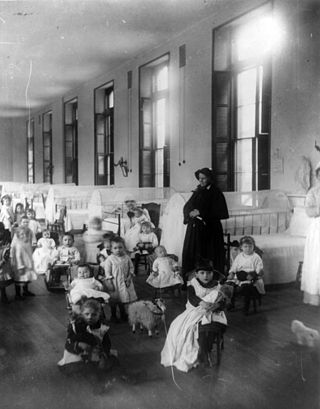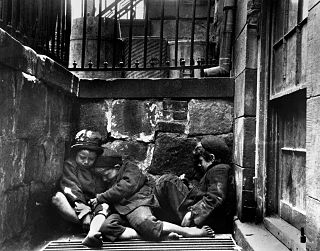
Adoption is a process whereby a person assumes the parenting of another, usually a child, from that person's biological or legal parent or parents. Legal adoptions permanently transfer all rights and responsibilities, along with filiation, from the biological parents to the adoptive parents.
International adoption is a type of adoption in which an individual or couple residing in one country becomes the legal and permanent parent(s) of a child who is a national of another country. In general, prospective adoptive parents must meet the legal adoption requirements of their country of residence and those of the country whose nationality the child holds.
Closed adoption is a process by which an infant is adopted by another family, and the record of the biological parent(s) is kept sealed. Often, the biological father is not recorded—even on the original birth certificate. An adoption of an older child who already knows their biological parent(s) cannot be made closed or secret. This used to be the most traditional and popular type of adoption, peaking in the decades of the post-World War II Baby Scoop Era. It still exists today, but it exists alongside the practice of open adoption. The sealed records effectively prevent the adoptee and the biological parents from finding, or even knowing anything about each other. However, the emergence of non-profit organizations and private companies to assist individuals with their sealed records has been effective in helping people who want to connect with biological relatives to do so.
Disruption is ending an adoption. While technically an adoption is disrupted only when it is abandoned by the adopting parent or parents before it is legally completed, in practice the term is used for all adoptions that are ended. It is usually initiated by the parents via a court petition, much like a divorce, to which it is analogous.
In the United States, adoption is the process of creating a legal parent–child relationship between a child and a parent who was not automatically recognized as the child's parent at birth.
Open adoption is a form of adoption in which the biological and adoptive families have access to varying degrees of each other's personal information and have an option of contact. While open adoption is a relatively new phenomenon in the west, it has been a traditional practice in many Asian societies, especially in South Asia, for many centuries. In Hindu society, for example, it is relatively common for a childless couple to adopt the second or later son of the husband's brother when the childless couple has limited hope of producing their own child.
Interracial adoption refers to the act of placing a child of one racial or ethnic group with adoptive parents of another racial or ethnic group.
The China Center of Adoption Affairs (CCAA) was established on June 24, 1996 by China's Ministry of Civil Affairs. The CCAA is responsible for the welfare of children in the care of Child Welfare Institutes (orphanages), domestic adoption, and international adoption.
Adoption in Connecticut means "the establishment by court order of the legal relationship of parent and child." Adoption is provided for in Title 45a of the Connecticut General Statutes. The provisions of this title, with a few exceptions are to be "liberally construed in the best interests of any child for whom a petition [for adoption] has been filed under said sections." Fundamentally, adoption is a two-step process: (1) an agreement to give and receive the child in adoption and (2) approval of said agreement by the probate court.
In the United States, Child and Family Services Reviews (CFSR) are conducted by the federal Children's Bureau, within the United States Department of Health and Human Services, to help states improve safety, permanency and well-being outcomes for children and families who receive services through the child welfare system. The Bureau conducts the reviews to ensure conformity with federal child welfare requirements, to determine what is actually happening to children and families in child welfare services, and to assist states in helping children and families achieve positive outcomes. The CFSRs monitor States' conformity with the requirements of title IV-B of the Social Security Act. The first round of reviews took place between 2000 and 2004 and the second round took place between 2007 and 2010. In both rounds, all States were required to implement Program Improvement Plans (PIPs) as part of the review process. The third round of CFSRs took place between 2015 and 2018; a complete aggregate report of those findings has yet to be released.
An adoption tax credit is a tax credit offered to adoptive parents to encourage adoption in the United States. Section 36C of the United States Internal Revenue code offers a credit for “qualified adoption expenses” paid or incurred by individual taxpayers.
The Uniform Adoption Act (1994) is a model law proposed by the U.S. Uniform Law Commission. It attempts to "be a comprehensive and uniform state adoption code that:
- is consistent with relevant federal constitutional and statutory law
- delineates the legal requirements and consequences of different kinds of adoption
- promotes the integrity and finality of adoptions while discouraging "trafficking" in minors
- respects the choices made by the parties to an adoption about how much confidentiality or openness they prefer in their relations with each other, subject, however, to judicial protection of the adoptee's welfare
- promotes the interest of minor children in being raised by individuals who are committed to, and capable of, caring for them."
Effects of adoption on the birth mother include stigma and other psychological effects a woman experiences when she places her child for adoption.
The Gladney Center for Adoption in Fort Worth, Texas, US, provides adoption and advocacy services. Following its 1880s origins, when it focused on locating homes for orphans during a period of mass migration. It evolved into lobbying, international adoptions, counseling, maternity services, education and philanthropy.
The following outline is provided as an overview of and topical guide to adoption:
Until 2017, laws related to LGBTQ+ couples adopting children varied by state. Some states granted full adoption rights to same-sex couples, while others banned same-sex adoption or only allowed one partner in a same-sex relationship to adopt the biological child of the other.

Foster care is the term used for a system in which a minor who has been made a ward or a non-minor, typically aged 18–21, who volunteers for placement, is placed in a relative placement, a non-related extended family (NREFM) placement, a community family home, an institution, a group home (residential child care community, residential treatment center, etc. Relative, NREFM, and community caregivers certified by the state are typically referred to as "foster parents," "kin caregivers," "resource parents," or other local terms. The placement of the child is usually arranged through state or county social services. The institution, group home, or caregiver is reimbursed for the expenses related to caring for the child. The state via the family court and child protection agency stand in loco parentis to the minor, making all legal decisions, while the caregiver is responsible for the day-to-day care of the minor. Even while their child is in Care, typically birth parents retain Education and Medical rights and the right to contact with their child unless parental rights are terminated by the Court.
Adoptive Couple v. Baby Girl, 570 U.S. 637 (2013), was a decision of the Supreme Court of the United States which held that several sections of the Indian Child Welfare Act (ICWA) do not apply to Native American biological fathers who are not custodians of a Native American child. The court held that the procedures required by the ICWA to end parental rights do not apply when the child has never lived with the father. Additionally, the requirement to make extra efforts to preserve the Native American family also does not apply, nor is the preferred placement of the child in another Native American family required when no other party has formally sought to adopt the child.

Nightlight Christian Adoptions is a national, non-profit, Hague-accredited, pro-life licensed adoption agency that counsels pregnant women and arranges adoptions. They have locations in ten U.S. states and arrange adoptions both domestically and internationally. The agency was founded in 1959. Nightlight was the first agency beginning in 1995 to organize a tour of the United States by group of orphaned Russian children. In 1997, the agency created the first program in the United States to arrange for couples to adopt frozen embryos.

Adoption in the Philippines is a process of granting social, emotional and legal family and kinship membership to an individual from the Philippines, usually a child. It involves a transfer of parental rights and obligations and provides family membership. The Department of Social Welfare and Development (DSWD) defines adoption as a "socio-legal process of giving a permanent family to a child whose parents have voluntarily or involuntarily given up their parental rights."




